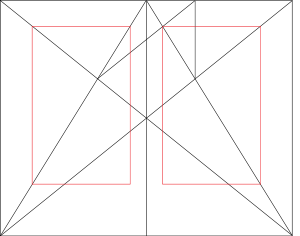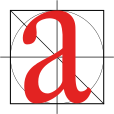Book design
From Wikipedia, the free encyclopedia
|
This article is part of the series on: Book design |
|
Book design is the art of incorporating the content, style, format, design, and sequence of the various components of a book into a coherent whole.
In the words of Jan Tschichold, book design "[...] though largely forgotten today, methods and rules upon which it is impossible to improve have been developed over centuries. To produce perfect books these rules have to be brought back to life and applied."[1] Richard Hendel describes book design as "an arcane subject" and refers to the need for a context to understand what that means.[2]
Contents |
[edit] Book structure
Book design concerns itself with the elements listed in the Book design sidebar.
[edit] Front matter
Front matter, or preliminaries, is the first section of a book, and is usually the smallest section in terms of the number of pages. The pages are numbered in lowercase roman numerals. Each page is counted; but no folio or page number is expressed, or printed, on either display pages, or blank pages.
Front matter generally only appears in the first volume in a series, although some elements (such as a table of contents or index) may appear in each volume.
The following table will help distinguish between some of the different types of front matter:
| Name | Voice | Purpose |
|---|---|---|
| Foreword | Some real person other than the author of the book | Often, a foreword will tell of some interaction between the writer of the foreword and the story or the writer of the story. A foreword to later editions of a work often explains in what respects that edition differs from previous ones. |
| Preface | The author | A preface generally covers the story of how the book came into being, or how the idea for the book was developed; this is often followed by thanks and acknowledgments to people who were helpful to the author during the time of writing. |
| Acknowledgement | The author | Often part of the Preface, rather than a separate section in its own right, it acknowledges those who contributed to the creation of the book. |
| Introduction | The author | A beginning section which states the purpose and goals of the following writing. |
| Dedication | The author | A dedication page is a page in a book that precedes the text, in which the author names the person or people for whom he/she has written the book. |
| Prologue | A character in the book |
[edit] Body matter
The structure of a work (and especially of its body matter) is often described hierarchically.
- Volumes
- A volume is a set of leaves that are bound together. Thus each work is either a volume, or is divided into volumes.
- Books and parts
- (Single-volume works account for most of the non-academic consumer market in books) A single volume may embody either a part or a book; in some works, parts include multiple books, and in some others books include multiple parts.
- Chapters and sections
- A chapter or section may be contained within a part and/or a book; when both chapters and sections are used in the same work, the sections are more often contained within chapters than the reverse.
The following are two instructive examples:
- The Lord of the Rings has three parts (either in a single volume, or in one volume each), with each part containing two books, each containing in turn multiple chapters.
- The Christian Bible (usually bound as a single volume) is nearly unique[citation needed] in being divided into two "testaments" (which might more typically be described as "parts", and differ in length by a factor of three or four), each containing dozens of books, each in turn containing multiple chapters, which are most often divided (for purposes of citation) into "verses" each containing roughly one independent clause.
[edit] Back matter
The back matter, if used, normally consists of one or more of the following components.
Epilogue — An epilogue is a piece of writing at the end of a work of literature or drama, usually used to bring closure to the work.
Extro/Outro — An extro or outro is the conclusion to a piece of work and is considered the opposite of the intro. These terms are more commonly used in music.
Afterword — An afterword (literature) is frequenty a piece of writing describing a time well after the time frame of the main story.
Conclusion — A conclusion.
Postscript — A postscript.
Appendix/Addendum — An appendix or addendum is a supplemental addition to a given main work. It may correct errors, explain inconsistencies or otherwise detail or update the information found in the main work.
Glossary — The glossary consists of a set of definitions of words of importance to the work. They are normally alphabetized. The entries may consist of places and characters, which is common for longer works of fiction.
Bibliography — The bibliography cites others used in the body. Most common in non-fiction books or research papers.
Index — An index is used to find terms used in the text. Most common in non-fiction books.
Colophon — The colophon is a brief description usually located at the end of a book, describing production notes relevant to the edition and may include a printer's mark or logotype.
[edit] Front cover, spine, and back cover of the dust-jacket

The front cover is the front of the book, and is marked appropriately, by text and/or graphics, in order to identify it as such, namely as the very beginning of the book. The front cover usually contains at least the title and/or author, with possibly an appropriate illustration.
The spine is the vertical edge of a book as it normally stands on a bookshelf. It is customary for it to have printed text on it. In texts published and/or printed in the United States, the spine text, when vertical, runs from the top to the bottom, such that it is right side up when the book is lying flat with the front cover on top. In books of Europe, vertical spine text traditionally runs from the bottom up, though this convention has been changing lately.[3] The spine usually contains all, or some, of four (4) elements (besides decoration, if any), and in the following order: (1) author, editor, or compiler; (2) title; (3) publisher; and (4) publisher logo.
The back cover often contains biographical matter about the author or editor, and quotes from other sources praising the book.
[edit] Binding
Books are classified under two categories according to the physical nature of their binding. The designation hardcover (sometimes hardback) refers to books with stiff covers, as opposed to flexible ones. The binding of a hardcover book usually includes boards (often made of cardboard) covered in cloth, leather, or other materials. The binding is usually sewn to the pages using string stitching.
A less expensive binding method is that used for paperback books (sometimes called softback or softcover). Most paperbacks are bound with paper or light cardboard, though other materials (such as plastic) are used. The covers are flexible and usually bound to the pages using glue (perfect binding). Some small paperback books are sub-classified as pocketbooks. These paperbacks are smaller than usual - small enough to barely fit into a pocket (especially the back pocket of one's trousers). However, this capacity to fit into a pocket diminishes with increasing number of pages and increasing thickness of the book. Such a book may still be designated as a pocketbook.
[edit] Page spread

A basic unit in book design is the page spread. The left page (called verso) and right page (called recto) are of the same size and aspect ratio, and are centered on the gutter where they are bound together at the spine.
The design of each individual page, on the other hand, is governed by the canons of page construction.
The possible layout of the sets of letters of the alphabet, or words, on a page is determined by the so-called print space, and is also an element in the design of the page of the book. Clearly, there must be sufficient space, at the spine of the book, if the text is to be visible. On the other hand, the other three margins of the page, which frame the book, are made of the appropriate size for both practical and aesthetic reasons.
[edit] Print space
The print space (German Satzspiegel) is a typographic term and determines the effective area on the paper of a book, journal or other press work. The print space is limited by the surrounding borders, or in other words the gutters outside the printed area.
The term comes originally from hot metal typesetting: above the desktop was a mirror (German: Spiegel) where the typesetter could read the inverted letters.
[edit] References
- ^ Tschichold, Jan, The Form of the Book (1991), Hartley & Marks, ISBN 0-88179-116-4
- ^ Hendel, Richard, On Book Design, Yale University Press, ISBN 0-300-07570-7
- ^ Petroski, Henry (1999). The Book on the Bookshelf. Alfred A. Knopf Inc. ISBN 0375406492.
- ^ Van de Graaf, J. A.. Nieuwe berekening voor de vormgeving. (1946)
[edit] Further reading
- Hendel, Richard, On Book Design, Yale University Press (1998) ISBN 0-300-07570-7.
- Hochuli, Jost, and Robin Kinross, Designing Books: Practice and Theory, Hyphen Press (1996) ISBN 0-907259-08-1.
- Bruno, Michael H., Pocket Pal: The Handy Little Book of Graphic Arts Production, 19th Edition, Graphic Arts Technical Foundation (2004) ISBN 0-88362-488-5.
- Lee, Marshal, Bookmaking: Editing, Design, Production, Third Edition, W. W. Norton and Company (2004) ISBN 0-393-73018-2.
- University of Chicago Press, The Chicago Manual of Style, 15th ed. (Chicago: 2003) ISBN 0226104036 (hardcover); ISBN 0226104052 (hardcover with CD-ROM): ISBN 0226104044 (CD-ROM).
- University of Chicago Press, The Chicago Manual of Style, 15th ed., Online ed. (Chicago: Released September 29.)
[edit] See also
|
|||||||||||
|
|||||||||||||||||||||||||||||||


